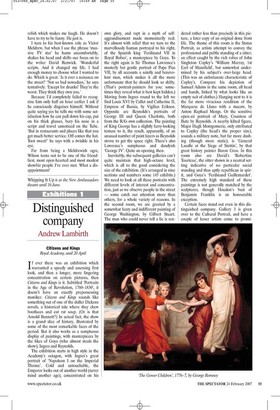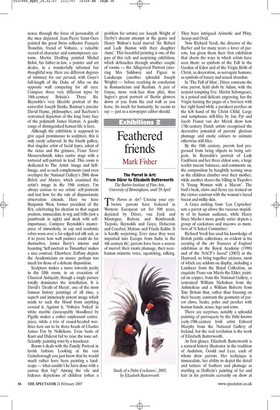Distinguished company
Andrew Lambirth Citizens and Kings Royal Academy, until 20 April If ever there was an exhibition which warranted a speedy and assessing first look, and then a longer, more lingering concentration on certain pictures, then Citizens and Kings is it. Subtitled 'Portraits in the Age of Revolution, 1760-1830', it doesn't have an exactly prepossessing moniker. Citizens and Kings sounds like something out of one of the duller Dickens novels, a historical tale where they chew bootlaces and eat rat soup. (Or is that Arnold Bennett?) In actual fact, the show is a grand slice of history, illustrated by some of the most remarkable faces of the period. But it also works as a sumptuous display of paintings, with masterpieces by the likes of Goya (who almost steals the show), Ingres and Reynolds.
The exhibition starts in high style in the Academy's octagon, with Ingres's great portrait of 'Napoleon I on the Imperial Throne'. Cold and untouchable, the Emperor looks out of another world (never mind another age), concentrated on his own glory, and rapt in a myth of selfaggrandisement made momentarily real. It's almost with relief that we turn to the marvellously human portrayal to his right, of the Spanish king 'Ferdinand VII in Royal Robes', a masterpiece by Goya. To the right again is Sir Thomas Lawrence's masterly but gentle portrait of Pope Pius VII, by all accounts a saintly and benevolent man, which makes it all the more unfortunate that he should look so shifty. (That's portrait-painters for you: sometimes they reveal what is best kept hidden.) Moving from Ingres round to the left we find Louis XVI by Callet and Catherine II, Empress of Russia, by Vigilius Eriksen. Opposite are Reynolds's portraits of George III and Queen Charlotte, both from the RAs own collection. The painting of King George has a slightly furry-looking texture to it, the result, apparently, of an unusual number of paint layers as Reynolds strove to get the space right. There's also Lawrence's sumptuous and dandyish 'George IV'. Quite an opening, then.
Inevitably, the subsequent galleries can't quite maintain that high-octane level, which is all to the good considering the size of the exhibition. (It's arranged in nine sections and numbers some 145 exhibits.) We need to look at all these portraits with different levels of interest and concentration, just as we observe people in the street — some catch our attention more than others, for a whole variety of reasons. In the second room, we are greeted by a somewhat fuzzy and indifferent painting of George Washington, by Gilbert Stuart. The man who could never tell a lie is rendered rather less than precisely in this picture, a later copy of an original done from life. The theme of this room is the Status Portrait, as artists attempt to convey the professional and public standing of a sitter; an effect caught by the rich robes of John Singleton Copley's 'William Murray, 1st Earl of Mansfield', but somewhat undermined by his subject's over-large head. (This was an unfortunate characteristic of Copley's. Compare his depiction of Samuel Adams in the same room, all head and hands, linked by what looks like an empty suit of clothes.) Hanging next to it is the far more vivacious rendition of the Marquesa de Llano with a macaw, by Anton Raphael Mengs. Or the sensitive open-air portrait of Mary, Countess of Bute by Reynolds. A nearby kilted figure, Major Hugh Montgomerie, only attributed to Copley (the head's the proper size), sounds a military note, but far more dashing (though more static), is 'General Lasalle at the Siege of Stettin', by that great history painter Baron Gros. In this room also are David's Robertine Tourteau', the sitter shown in a neutral setting indicative of no particular social standing and thus aptly republican in spirit, and Goya's 'Ferdinand Guillemardet'. The extremely high standard of these paintings is not generally matched by the sculptures, though Houdon's bust of Benjamin Franklin is an honourable exception.
Certain faces stand out even in this distinguished company. Gallery 3 is given over to the Cultural Portrait, and here a couple of lesser artists come to prominence through the force of personality of the men depicted. Jean-Pierre Saint-Ours painted the great Swiss collector Francois Tronchin, friend of Voltaire, a valuable record of character and contemporary customs. Martin Drolling painted Michel Belot, his father-in-law, a painter and art dealer, in a wonderfully informal but thoughtful way. Here are different degrees of intimacy for our perusal, with Goya's full-length of the Duke of Alba on the opposite wall competing for all eyes. Compare three very different types by 18th-century Britain's Three Rs: Reynolds's very likeable portrait of the naturalist Joseph Banks, Ramsay's porcine David Hume, philosopher, and Raeburn's restrained depiction of the long bony face of the polymath James Hutton. A goodly range of distinguished human life is here.
Although the exhibition is supposed to give equal prominence to sculpture, this is only rarely achieved. In the fourth gallery, that singular artist of facial types, adept of the rictus and the grimace, Franz Xaver Messerschmidt, takes centre stage with a tortured self-portrait in lead. This room is dedicated to The Artist: Image and SelfImage, and as such complements (and even overlaps) the National Gallery's 2006 show Rebels and Martyrs, which examined the artist's image in the 19th century. I'm always curious to see artists' self-portraits and test how far the rule of dispassionate observation extends. Here we have Benjamin West, former president of the RA, celebrating his election to that august position, immaculate in wig and frills (not a paintbrush in sight) and sleek with selfimportance. Compare Reynolds's masterpiece of immodesty, in cap and academic robes worn over a fur-edged red silk suit, as if to prove how well painters could do for themselves. James Barry's intense and haunting 'Self-portrait as Timanthes' makes a nice contrast. Elsewhere Zoffany depicts the Academicians en masse: perhaps too much for those of a delicate disposition.
Sculpture makes a move towards parity in the fifth room, in an evocation of Classical Antiquity, though a single picture totally dominates the installation. It is David's 'Death of Marat', one of the most famous history paintings of all time, a superb and immensely potent image which tends to suck the blood from anything around it. Against it, 'Voltaire Naked' in white marble (inescapably bloodless) by Pigalle makes a rather unpleasant centrepiece, while a trio of round-headed worthies turn out to be three heads of Charles James Fox by Nollekens. Even busts of Kant and Diderot fail to raise the tone sufficiently: painting wins by a knockout.
Room 6 deals with the Family Portrait in lavish fashion. Looking at the vast Gainsborough you just know that he would much rather have been painting a landscape — what couldn't he have done with a canvas that big? Among the vile and hideous depictions of children (often a problem for artists) are Joseph Wright of Derby's decent attempt at the genre and Henry Walton's lucid marvel 'Sir Robert and Lady Buxton with their daughter Anne'. This beautiful painting is one of the joys of this rich and surprising exhibition, which debouches through another couple of rooms — the Allegorical Portrait (starring Mrs Siddons) and Figure in Landscape (another splendid Joseph Wright) — before reaching its conclusion in Romanticism and Realism. A pair of Goyas, more rock-face than phiz, then Ingres's great portrait of Bertin glowers down at you from the end wall as you leave. So much for humanity, he seems to say — just as a newspaper editor should.























































 Previous page
Previous page